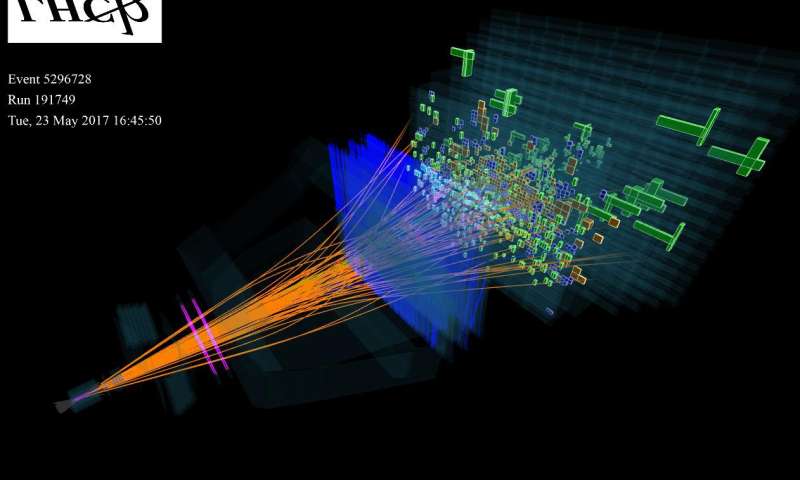博文
粒子物理学家在追求“新物理学”
|||
粒子物理学家在追求“新物理学”
诸平

After five years of work, EPFL's physicists, together with some 800 international researchers involved in the CERN's LHCb project, have just taken an important step by building a new detector -- a scintillating fiber tracker dubbed SciFi -- to harvest more data from the collider. Credit: CERN
据物理学家组织网(Phys.org)2017年9月6日报道,经过五年的努力工作,瑞士洛桑联邦理工学院(école Polytechnique Fédérale de Lausanne,EPFL)的物理学家与欧洲核子研究组织(Conseil Européenne pour la Recherche Nucléaire,通常被简称为CERN)的约800名国际研究人员一起参与了欧洲核子研究中心(CERN)的LHCb项目,通过建立一种新探测器为粒子研究已经迈出了重要的一步。这种新探测器是一种光纤追踪器被称为SciFi,可以从对撞机捕获到更多的数据。CERN拥有世界上最大型的粒子物理学实验室。机构位于瑞士日内瓦西部与法国接壤的边境。该组织成立于1954年9月29日,为科学家提供必要的工具。最初,欧洲核子研究组织的签字发起国有12个,现在会员国约增加到20个。欧洲核子研究组织已经聘用大约三千名的全职员工。并有来自80个国籍的大约6500位科学家和工程师,代表500余所大学机构,在CERN进行试验。这大约占了世界上的粒子物理学圈子的一半。尽管CERN的大型强子对撞机(LHC)每秒会产生上亿质子对撞。但研究人员致力于大型强对撞机(LHCb)实验,其中包括来自EPFL的物理学家,能够记录的碰撞非常有限,安装在加速器上的探测器只能捕获到上亿质子对撞中的2000个。这样的捕获结果让物理学家觉得意犹未尽,只能期待新技术的诞生。SciFi的出现,使他们确信绝大部分未捕获的数据中可能蕴藏着一些悬而未解问题的答案,追求“新物理学”就在其中。更多信息请注意浏览原文或者相关报道。
Particle physicists on a quest for 'new physics'
September 6, 2017
After five years of work, EPFL's physicists, together with some 800 international researchers involved in the CERN's LHCb project, have just taken an important step by building a new detector—a scintillating fiber tracker dubbed SciFi—to harvest more data from the collider.
The Large Hadron Collider (LHC) at CERN, the European Organization for Nuclear Research, produces hundreds of millions of proton collisions per second. But researchers working on the Large Hadron Collider beauty (LHCb) experiment, which involves physicists from EPFL, can only record 2,000 of those collisions, using one of the detectors installed on the accelerator. So in the end, this technological marvel leaves the physicists wanting more. They are convinced that the vast volume of uncaptured data holds the answers to several unresolved questions.
In elementary particle physics, the Standard Model - the theory that best describes phenomena in this field - has been well and truly tried and tested, yet the researchers know that the puzzle is not complete. That's why they are studying phenomena that are not accounted for by the Standard Model. This quest for "new physics" seeks to explain the disappearance of antimatter after the Big Bang and the nature of the dark matter that, although it represents around 30% of the universe, can only be detected by astronomical measurements at this point.
"To extract more information from the LHC data, we need new technologies for our LHCb detector," says Aurelio Bay from EPFL's Laboratory for High Energy Physics. EPFL has teamed up with several research institutes to develop the new equipment that will upgrade the experiment in 2020.
Using scintillating fiber to detect particles
After five years of work, EPFL's physicists, together with some 800 international researchers involved in the LHCb project, have just taken an important preliminary step towards significantly enhancing their experimental equipment. They have decided to build a new detector - a scintillating fiber tracker dubbed SciFi.
Construction of the tracker, which incorporates 10,000 kilometers of scintillating fibers each with a diameter of 0.25mm, has already begun. When particles travel through them, the fibers will give off light signals that will be picked up by light-amplifying diodes. The scintillating fibers will be arranged in three panels measuring five by six meters, installed behind a magnet, where the particles exit the LHC accelerator collision point. The particles will pass through several of these fiber 'mats' and deposit part of their energy along the way, producing some photons of light that will then be turned into an electric signal.
Data on how the particles traverse the fibers will be enough to reconstruct their trajectory. The physicists will then use this information to restore their primitive physical state. "What we will essentially be doing is tracing these particles' journey back to their starting point. This should give us some insight into what happened 14 billion years ago, before antimatter disappeared, leaving us with the matter we have today," says Bay.
Huge data flows
SciFi is a key component for acquiring data at the highest speed, as it includes filters that are designed to preserve only useful data. In an ideal world, the physicists would collect and analyze all of the data without needing to use too many filters. But that would involve a massive amount of data.
"We may already be at the limit, because we of course have to save the data somewhere. First we use magnetic storage and then we distribute the data on the LHC GRID, which includes machines in Italy, the Netherlands, Germany, Spain, at CERN, and in France and the UK. Many countries are taking part, and numerous studies on this data are being run simultaneously," adds Bay. He points to his computer screen: red is used to denote programs that are not working well or those that have been trying for several days to be included among the priorities.
Bay neatly puts this initiative into a physicist's perspective: "If the LHC doesn't have enough power to uncover new physics, it's all over for my generation of physicists! We will have to come up with a new machine, for the next generation."
![]() Explore further:New source of asymmetry between matter and antimatter
Explore further:New source of asymmetry between matter and antimatter
https://blog.sciencenet.cn/blog-212210-1074605.html
上一篇:佩吉·惠特森:破记录的美国宇航员返回地面
下一篇:早期胰腺癌检查新方法